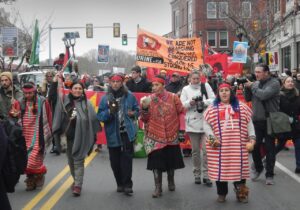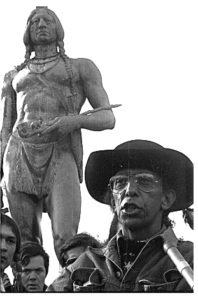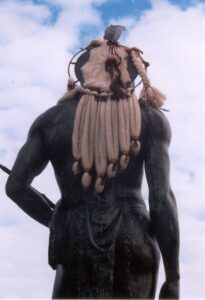by Mariella David and Cathy Klingler
Content warning: The following article discusses themes of war and racism.
.
.
.
.
.
For most of the United States, the fourth Thursday in November marks the holiday of Thanksgiving. For many Native Americans, the day is not one of thanks but sorrow. The National Day of Mourning commemorates a long history of assaults on the Indigenous way of life.
Rewriting History
The traditional Thanksgiving holiday remembers a feast given in 1621 by pilgrims who had escaped from religious persecution in England. The celebration welcomed the local Indigenous people, members of the Wampanoag Nation. The pilgrims and the Wampanoag sat down together as friends, sharing the bounty of the land.
At least, that is how the legend goes. The reality is not so charming.
Personal accounts of the “first Thanksgiving” indicate that it was not a feast and was most likely a simple harvest meal. Instead of November, it may have occurred as early as September or as late as December. Most of the foods associated with Thanksgiving, including turkey, mashed potatoes, and pumpkin pie, were not available. In fact, the meal was most likely venison, turnips, porridge, and clams.
More important than the menu is the romanticized tale disguising the truth that with the colonists came war. The arrival of the colonists began an era of aggression toward the original inhabitants of the American continent. Rather than a day of thanks, many Indigenous peoples see Thanksgiving as a sad reminder of a violent past and a loss of their culture.
A New Narrative
The Wampanoag Nation was a key force in establishing the National Day of Mourning in 1970. Wamsutta (Frank) James, leader of the Wampanoag, was invited to speak at a Thanksgiving event. In defense of his culture, Frank wrote a fierce speech that upended the traditional holiday narrative. The event organizers rejected his speech against colonialism and asked him not to appear at the event.
Frank was not so easily dismissed. He and his fellow Wampanoag marched to Cole’s Hill in Plymouth, Massachusetts, near where the pilgrims came ashore. Frank gave his original speech next to a statue of former Wampanoag leader Massasoit. Frank spoke of nearly 400 years of enslavement, disease, and racism that had all but wiped out the Wampanoag culture. With Frank’s speech, the first National Day of Mourning was created.
To learn more about the history of this observance and its organizers, explore the website of the
United American Indians of New England.
Changing the Conversation
To better appreciate the impact of the National Day of Mourning, we asked Donavon Soumas, EdD, the Assistant Manager for Diversity, Equity, Inclusion, and Belonging (DEI&B) at Random Acts, a few questions. Donavon has more than two decades of experience working toward DEI&B goals in both corporate settings and non-profit and heritage spaces.
Random Acts: What is the perspective of Random Acts about the National Day of Mourning?
Dr. Donavon Soumas: I think the observance serves as an opportunity to reflect on the broader principles of empathy, compassion, and social justice. When we observe this day, we can show empathy and support for marginalized communities and contribute to a more just and compassionate society.
What issues face Indigenous populations?
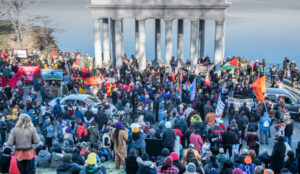
Attendees assemble at Cole’s Hill for National Day of Mourning observance. Image: http://www.uaine.org/
Indigenous communities in the US have a long history of trauma, including forced removal from ancestral lands, cultural assimilation efforts, and violence. Additionally, many Native Americans face risks related to environmental problems, e.g., water contamination, dumping, air pollution, mining waste, and climate change.
Today, Native Americans also face educational inequities. According to the Native American Rights Fund, native students perform two to three grade levels below their white peers in reading and mathematics. They are 237% more likely to drop out of school and 207% more likely to be expelled than white students.
In addition, the cultural preservation of languages, traditions, and cultures are ongoing issues Indigenous people face. Sadly, the Native community faces cultural appropriation, assimilation efforts, and the erosion of traditional Indigenous knowledge today.
What measures does the Diversity, Equity, Inclusion, and Belonging community take to raise awareness about marginalized populations?
Within the DEI&B Team, several measures are being taken. Here are four of our initiatives and strategies:
- Internal Cultural Awareness Training and Q&A sessions: The DEI&B Team is actively organizing cultural awareness training sessions for all volunteers.
- Monthly Cultural Events: To promote awareness and appreciation of diverse cultures, the DEI&B Team has planned to highlight two cultural events per month.
- Collaboration with Affinity Groups: The DEI&B Team collaborates closely with our Affinity Groups (i.e., Disabilities, LGBTQIA+, and BIPOC), representing various marginalized populations within the organization.
- Inclusive Communication: The DEI&B Team will work to ensure that communication and messaging throughout the organization reflect a commitment to diversity, equity, inclusion, and belonging.
What can our supporters do to ensure authentic stories and lived experiences are elevated in their own communities?
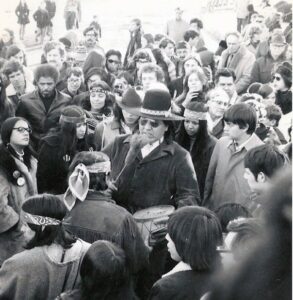
Vintage photo of Wampanoag participating in National Day of Mourning observance. Wampanoag participating in National Day of Mourning observance. Image: http://www.uaine.org/
Engage with and support initiatives that promote kindness and inclusivity. I believe there are several things people can do to ensure authentic stories and lived experiences are elevated in their community:
- Actively listen: take time to listen actively to the stories and experiences of individuals from diverse backgrounds. Listening is the first step in understanding and empathizing with the challenges and perspectives of others.
- Amplify quiet voices: amplify the voices and stories that may not be widely heard. Sharing others’ stories through social media, community events, or other channels to raise awareness and build understanding can be a powerful way to create positive change.
- Inclusivity is key: advocate for Inclusivity in the workplace, school, or community organizations. Additionally, people can also encourage policies and practices that embrace diversity and provide opportunities for authentic storytelling.
In addition to these ideas, people can create and/or establish safe and supportive spaces where people feel comfortable sharing their authentic stories.
Are there websites or other resources you would recommend on this topic or DEI&B in general?
There are many websites and resources available on the topics of DEI&B that can provide valuable information, guidance, and tools. Here are a few of my favorite recommendations:
Websites:
- Diversity, Equity, and Inclusion at work: visit the Diversity, Equity & Inclusion Resource Center by the Society for Human Resource Management (SHRM). They offer a comprehensive collection of resources for workplace DEI efforts.
- Educators who teach awareness: I suggest the Southern Poverty Law Center (SPLC). They provide free resources for educators to promote equity and inclusivity in schools.
- Community engagement efforts: I recommend making a visit to the Community Tool Box website. They provide practical resources and guides for community development and engagement, including strategies for promoting diversity and inclusion.
Books:
- So You Want to Talk About Race by Ijeoma Oluo
- The Color of Law by Richard Rothstein
- White Fragility by Robin DiAngelo
- How to Be an Antiracist by Ibram X. Kendi
Local Acts Add Up to Global Good
At Random Acts, our mission is to fund acts of kindness, both large and small. Do you have an idea for an act of kindness in your own community? Contact your local Random Acts Regional Representative for information on Sponsored Acts or any other help you need to turn your idea into a reality.

